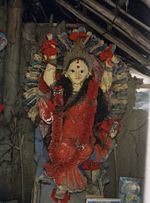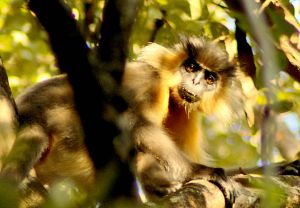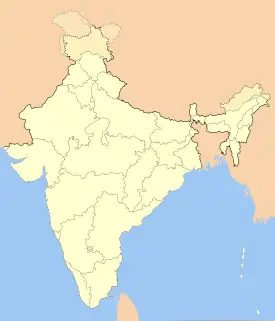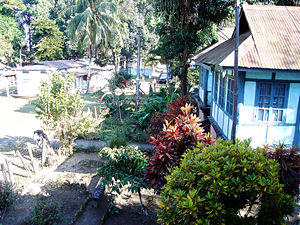Manas National Park
| Manas Wildlife Sanctuary* | |
|---|---|
| UNESCO World Heritage Site | |
| State Party | |
| Type | Natural |
| Criteria | vii, ix, x |
| Reference | 338 |
| Region** | Asia-Pacific |
| Inscription history | |
| Inscription | 1985 (9th Session) |
| Endangered | 1992 |
| * Name as inscribed on World Heritage List. ** Region as classified by UNESCO. | |
The name of the park, Manas National Park, originates from the Manas River, named after the serpent god Manasa. The Manas river serves as a major tributary of Brahmaputra River, which passes through the heart of the national park. Manas National Park has been designated a National Park, UNESCO Natural World Heritage site, a Project Tiger Reserve, an Elephant Reserve and a Biosphere Reserve in Assam, India. It is Located in the Himalayan foothills, with a part extending to Bhutan. The park has become well know for its rare and endangered wildlife, found nowhere else in the world, like the Assam Roofed Turtle, Hispid Hare, Golden Langur and Pygmy Hog.
The Indian government has shown tremendous vision by designating Manas a national park, tiger reserve, reserved forest, and welcoming the World Heritage Site designation. Faced with the need to survive, villagers living on the periphery of the park have presented the Indian government with an enormous challenge of protecting the wildlife and plant life. By accepting that challenge, India is leading the way for other countries with parks in developing regions. The tension between preserving wildlife habitat for future generations, and helping poverty level people eat and find shelter in this generation, has been playing out at Manas National Park in an admirable way.
History
The Manas National Park, declared a sanctuary on October 1, 1928, has an area of 360 sq. km. Manas Tiger reserve inaugurated in 1973. Prior to the declaration of the sanctuary, the park had been designated as a Reserved Forest, called Manas Reserved Forest and North Kamrup Reserved Forest. The Cooch Behar royal family and Raja of Gauripur used the park as a hunting reserve. In 1951 and 1955, the government increased the area to 391 sq. km. In December 1985, UNESCO declared Manas a World Heritage site. The Indian government added Kahitama Reserved Forest, the Kokilabari Reserved Forest and the Panbari Reserved Forest in the year 1990 to form the Manas National Park. In 1992, UNESCO revised their designation to a World Heritage Site in danger due to heavy poaching and terrorist activities.
Only one forest village, Agrang, exists within the park, situated at the center the National Park. In addition to that village, fifty six villages surround the park. Many more fringe villages directly or indirectly depend on the park for their livlihood.
Geography
The park area falls in six districts: Kokrajhar, Bongaigaon, Barpeta, Nalbari, Kamrup and Darrang in the state of Assam in India. Manas, sitting in the Eastern Himalayas foothills, has dense forests throughout. The Manas river, the main river and a major tributary of Brahmaputra river, flows through the western section of the park, dividing into two separate rivers, the Beki and Bholkaduba. The Manas river, and five other small rivers, flow through the National Park which lies on a wide low-lying alluvial terrace below the foothills of the outer Himalaya.
Limestone and sandstone make up the bedrock of the savanna area in the north of the park, whereas deep deposits of fine alluvium soil nourish the grasslands in the south of the park. Sub-Himalayan Bhabar Terai formation, combined with riverine succession continuing up to Sub-Himalayan mountain forest, make the region one of the richest biodiversity areas in the world. The park measures 391 km² in area and is situated at a height of 61m to 110m above mean sea level.
The minimum temperature reaches around 15 °C while maximum temperature measures around 37 °C. Heavy rainfall occurs between May and September; the park has an the annual average rainfall of around 333 cm.
Natural History
| Manas National Park | |
|---|---|
| IUCN Category II (National Park) | |
| Location: | Assam, India |
| Nearest city: | Barpeta Road |
| Area: | 391 km². |
| Established: | 1990 |
| Visitation: | NA (in NA) |
| Governing body: | Ministry of Environment and Forests, Government of India |
Biomes
Two major biomes exist in Manas:
- The grassland biome
- The forest biome
Flora
Vegetation: The Burma Monsoon Forests of Manas lie on the borders between the Indo-Gangetic and Indo-Malayan biogeographical realms and belong to the Brahmaputra Valley Biogeographic Province. The combination of Sub-Himalayan Bhabar Terai formation with riverine succession leading up to Sub-Himalayan mountain forest makes it one of the richest biodiversity areas in the world.
The following comprise the main vegetation types:
- i) Sub-Himalayan Light Alluvial Semi-Evergreen forests in the northern parts.
- ii) East Himalayan mixed Moist and Dry Deciduous forests (the most common type).
- iii) Low Alluvial Savanna Woodland, and
- iv) Assam Valley Semi-Evergreen Alluvial Grasslands which cover almost 50 percent of the Park.
Much of the riverine dry deciduous forest grows at an early successional stage. Moist deciduous forest replaces it away from water courses, succeeded by semi-evergreen climax forest in the northern part of the park. A total of 543 plants species have been recorded from the core zone. Of those, dicotyledons (including 89 trees) make up 374 species, 139 species monocotyledons and 30 Pteridophytes and Gymnosperms.
The Park's common trees include Aphanamixis polystachya, Anthocephalus chinensis, Syzygium cumini, S. formosum, S. oblatum, Bauhinia purpurea, Mallotus philippensis, Cinnamomum tamala, Actinodaphne obvata, Bombax ceiba, Sterculia villosa, Dillenia indica, D. pentagyna, Careya arborea, Lagerstroemia parviflora, L. speciosa, Terminalia bellirica, T. chebula, Trewia polycarpa, Gmelina arborea, Oroxylum indicum and Bridelia spp. Imperata cylindrica, Saccharum naranga, Phragmites karka, Arundo donax, Dillenia pentagyna, Phyllanthus emblica, Bombax ceiba, and species of Clerodendrum, Leea, Grewia, Premna and Mussaenda dominate the Grasslands.
Fauna
The park has recorded fifty five species of mammals, 380 species of birds, fifty of reptiles, and three species of amphibians. Out of those wildlife, twenty one mammals belong to India’s Schedule I mammals and thirty one have been placed on the threatened list. The fauna of the park includes Tigers, Elephants, Rhinoceros, Wild Buffaloes, Leopards, Clouded Leopards, Gaurs, Swamp Deer, Capped Langurs, Golden Langurs, Assamese Macaques, Slow Loris, Hoolock Gibbons, Smooth Indian Otters, Sloth Bears, Barking Deer, Hog Deer, Sambar and Chital.
The park has become famous for its rare and endangered wildlife, found only in Manas Park like the Assam Roofed Turtle, Hispid Hare, Golden Langur and Pygmy Hog. Manas serves as home to about 380 species of birds. Manas have the largest population of endangered Bengal Florican. The major other birds includes Giant Hornbills, Jungle Fowls, Bulbuls, Brahminy Ducks, Khaleej Pheasants, Egrets, Pelicans, Fishing Eagles, Serpent Eagles, Falcons, Scarlet Minivets, Bee-Eaters, Magpie Robins, Pied Hornbills, Gray Hornbills, Mergansers, Harriers, Ospreys and Herons.
Park-specific information
Activities
Powerful binoculars, with night vision facilities at night, represent the best way to watch wildlife at the park. The four-wheel (Jeep) drive petrol vehicle offers the ideal way to explore most of the Manas National Park in Assam. A boat ride on Manas river, commencing at Mathanguri and ending around 35km away, offers another popular option. The elephant rides, organized by the park authorities from Mathanguri, constitute the third option, a favorite with most visitors. Those take the visitor deep in to the densest areas of the forest and often in close quarters with the wildlife, including elephants, rhinos and wild buffaloes. The park closes during the Monsoon season.
Lodging
The Forest Lodge sits inside the park at Mothanguri.
Manas Jungle Camp, a Community cum Conservation Tourism project in Kokilabari, sits near Eastern Core area of the Manas National Park. Run by the local Conservation NGO MMES (Manas Maozigendri Ecotourism Society), the organization has as its stated mission the revival of Manas and removal from the UNESCO Red-list. The camp has 40 ethnic cottages in a Rubber Plantation near the park boundary. The project runs various conservation programs, Cultural self-help groups, Handicraft self-help groups, and conducts regular patrolling inside the park in association with the Forest department to stop poaching, cattle grazing. That initiative has received appreciation from the UNESCO World Heritage Commission, and visitors from around the world. Many consider MMES a major development towards the revival of Manas.
Approach
- Nearest airport: Borjhar
- Nearest railhead: Barpeta Road
- Nearest Highway: NH 31 (22 km away)
- Nearest town: The town of Barpeta Road is next to the park boundary and entrance.
- Nearest city: The city of Guwahati is 176 km away from the park.
ReferencesISBN links support NWE through referral fees
- Choudhury, Anwaruddin. Birds of Manas National Park. Gibbon pocket guides. Assam: Gibbon Books, 2006.
- Hajra, P. K., and S. K. Jain. Botany of Kaziranga and Manas. Dehra Dun: Surya International, 1996. ISBN 9788185276359
- Thakur, Sivasish, and Dushyant Parasher. Manas National Park A Pictorial Handbook. Guwahati: Red River, 2007.
- World Wide Fund for Nature, and Charles Santiapillai. Management of the Proposed Royal Manas National Park, Bhutan A Report on the Visit to Bhutan. Bogor, Indonesia: World Wildlife Fund Indonesia Programme, 1988. OCLC: 77023490
| |||||||
Credits
New World Encyclopedia writers and editors rewrote and completed the Wikipedia article in accordance with New World Encyclopedia standards. This article abides by terms of the Creative Commons CC-by-sa 3.0 License (CC-by-sa), which may be used and disseminated with proper attribution. Credit is due under the terms of this license that can reference both the New World Encyclopedia contributors and the selfless volunteer contributors of the Wikimedia Foundation. To cite this article click here for a list of acceptable citing formats.The history of earlier contributions by wikipedians is accessible to researchers here:
The history of this article since it was imported to New World Encyclopedia:
Note: Some restrictions may apply to use of individual images which are separately licensed.




